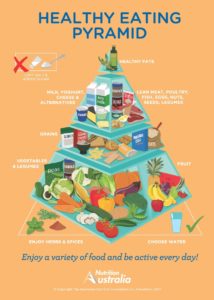
16 Jun A Pyramid of Food- Where to Start?
Re-inventing the Pyramid: Are you confused about how to eat?
An interview with NatMed’s associate nutritionist, Adrian Adams
A new food pyramid has been released by Nutrition Australia and has made some rather dramatic changes compared to previous revisions of the pyramid. Currently, Australia is exposed to a handful of large organisations that release national food guidelines working off the back of the governments “Dietary Guidelines for Australians 2013”. For the most part, these organisations (Nutrition Australia being one of them) have followed the guidelines set by the government. So, why has this organisation changed its pyramid? Is there new evidence of certain food groups being recommended in too high amounts? Or is it just representing what clinicians are actually recommending? Why the change? To answer these questions and more I have NatMed’s resident associate nutritionist, Adrian Adams.
Q. What are the changes to the food pyramid that Nutrition Australia has released?
“Well basically the bottom layer that represents the eat most of, is not represented by grains, cereals, breads, pasta etc. It now contains vegetables, fruits and legumes. There is also no top section that recommends small amounts of fast food and confectionary in a healthy diet and herbs/spices are featured also. The herbs and spices have been in past pyramids”
Q. What do you think of the changes?
“The changes are a great step in the right direction and I fully support them. It is representing the dietary patterns that most clinicians in the complementary medicine field and some circles of dieticians have been recommending for years. The emphasis away from large amounts of pasta, bread, rice and other carbohydrates consumption will help the Australian public avoid many diseases such as diabetes and obesity. The removal of junk food and confectionary from the pyramid is a good move also, since these foods have no health benefit to the population”
Q. Why are bread, pasta, rice and even wholegrain so bad?

Q. What has changed in nutritional research?
“The largest proportion of food within a healthy diet is fresh vegetable, fruit and water, any clinician whether a complementary therapist, nutritionist or dietician would all agree. This is because the plant chemicals and nutrients found in this group are so disease preventative. The research that backs this up has been around for decades, so there has been no change in research findings just more mounting evidence to change government and large health organisations minds”
Q. Why have these changes been so late in coming to the public domain?
“The Australian Guide to Healthy Eating” was revised in 2013 and made some mediocre changes to their previous guidelines such as recommending to eat mostly whole grains. The revision of nutritional research is slow in Australia and the government take a very cautious approach to dietary guideline changes. In my opinion and many of my colleagues there seems to be caution in too much change in recommendations due to government organisations feeling embarrassed and the possibility of losing the trust of the Australian public if they said they were wrong. I applaud Nutrition Australia’s quite large step forward in comparison.
Q. What would you like to see happen in the future with dietary guidelines?
“I would like to see the research that I read and implement to improve my clients health be fast tracked to the public. The removal of old recommendations that relate to poor research done in the 70’s and updated accordingly. Treating the Australian public as an educated population that wants up to date recommendations to allow them to make informed decisions if they want to avoid lifestyle diseases. Lastly, the implementation of multiculturalism into our dietary recommendation we are not all Caucasian descent and the pyramid should reflect this more”.
For more information, see below.
You can contact Adrian Adams, Nutritionist/Naturopath BHSc (Nutrition & Naturopathy) at NatMed Natural Medicine Clinic 9339 1999.
Interview conducted by Jade Delaney 26/05/2015
Nutrition Australia
https://nutritionaustralia.org/national/resource/healthy-eating-pyramid
Australian Guidelines for Healthy Eating
https://www.eatforhealth.gov.au/guidelines/australian-guide-healthy-eating
